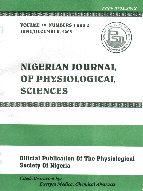
|
Nigerian Journal of Physiological Sciences
Physiological Society of Nigeria
ISSN: 0794-859X
Vol. 26, No. 2, 2011, pp. 125-132
|
 Bioline Code: np11019
Bioline Code: np11019
Full paper language: English
Document type: Research Article
Document available free of charge
|
|
|
Nigerian Journal of Physiological Sciences, Vol. 26, No. 2, 2011, pp. 125-132
| en |
Analysis of heterogeneity of Copia-like retrotransposons in the genome of Cassava ( Manihot esculenta  Crantz) Crantz)
Gbadegesin, M.A & Beeching, J.R
Abstract
Retrotransposons are ubiquitous in eukaryotic genomes and now proving to be useful genetic tools for genetic diversity and phylogenetic analyses, especially in plants. In order to assess the diversity of Ty1/Copia-like retrotransposons of cassava, we used PCR primers anchored on the conserved domains of reverse transcriptases (RTs) to amplify cassava Ty1/Copia-like RT. The PCR product was cloned and sequenced. Sequences analysis of the clones revealed the presence of 69 families of Ty1/Copia-like retrotransposon in the genome of cassava. Comparative analyses of the predicted amino acid sequences of these clones with those of other plants showed that retroelements of this class are very heterogeneous in cassava. Cassava is widely grown for its edible roots in the tropical and subtropical regions of the world. Cassava roots, though poor in protein, are rich in starch (makes up about 80% of the dry matter), vitamin C, carotenes, calcium and potassium. It has a great commercial importance as a source of starch and starch based products. Realizing the importance of cassava, it stands out as a crop to benefit from biotechnology development. Heterogeneity of Mecops (Manihot esculenta copia-like Retrotransposons) showed that they may be useful for genetic diversity and phylogenetic analyses of cassava germplasm.
Keywords
Cassava; transposable-elements; retrotransposons; retroviruses; Manihot esculenta; Ty1/Copia
|
| |
© Copyright 2011 - Physiological Society of Nigeria
|
|
